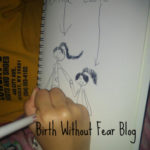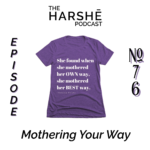
I wrote this post just after getting back from the inaugural Birth Without Fear conference almost a year ago. The dust had settled, baby E was back on her (haywire, semi-self-directed) routine, and I had finally stopped wearing my lanyard. I took a few minutes to reflect on my experience and gloat over my new Beco. What was it like? What did I learn?
It was like this: the whole thing was nothing short of amazing. I got to meet women whose names I would recognize anywhere but whose voices were foreign to me. Some (the other BWF admins/contributors) were already close friends and meeting them felt strangely uneventful: they are who I thought they were, and they are perfect. Others, I knew only that I liked them – that I usually read their comments, that I tended to click ‘like’ (Piper! Dani! Laney! Molly!) – but little else. Seeing their faces, their families, their enthusiasm for birth choices, well… I was basically crying a little bit in my mouth all weekend.
Something powerful happens when women come together to support each other. Something tear-filled, something messy, something noisy and peaceful; it’s a soft chuckle and a baby’s wail and a hug from someone who loves you all at the same time.
It’s great. We should do it again sometime. ((We are doing it again sometime, and that time is October 25-26!))
Lots of beautiful pictures have been posted on the BWF Facebook page, including this one from Leilani Rogers (love that lanyard!).
I had a great time on stage, presenting my talk on postpartum care, Mothering the Mother and just generally making a fool out of myself, sponsored by the Beauty “We Don’t Suck In Our Bellies” Revealed Project. No pictures survive from this 45-minute section of the conference and I absolutely, 100% most certainly did not bribe the photographers to make this happen.
I talked about nursing lingerie, feminism, motherhood as political activism, birth in America, postpartum traditions historically and cross-culturally, and how even them tougher-than-guts pioneer ladies didn’t do postpartum alone (no! they had friends who looked after them on rotation for two weeks! the term ‘gossip’ comes from the words ‘god-sib’, meaning a sibling who takes care of you and makes you laugh). And, thanks to a seriously 1990’s last-minute powerpoint presentation prepared by my awesome husband, I showed some kittens.
I also handed out a draft of a four-week postpartum plan. It is based on an idea I learned in my Stillbirthday Doula training of birth as a five-stage process – active labor, pushing, afterbirth, the first three days of baby’s life when colostrum is produced; and the first six weeks when bonding is solidifying and breastfeeding may be established. This plan can assist the mother and her community in providing care that works for her during the last two stages. It can and should be adapted to each woman’s individual circumstances. In fact, I’d love to hear what changes you would make to it. As always, let us know in the comments.*
*I would be particularly honoured to hear from families who have birthed their babies via C-section or adopted. This plan was written with vaginal birthing mamas in mind and I’m sure there are special considerations it does not touch on.
A downloadable version is available here.
Feel free to use and reproduce at will with credit to me (Svea Boyda-Vikander-of-the-Kittens) and Birth Without Fear.
Mothering the Mother: A PostPartum Plan
Svea Boyda-Vikander, Birth Without Fear Conference 2013
Names (both parents):
Guess Date:
Baby’s older siblings:
The Basics:
Food:
How will you get your meals?
How will your pantry be filled?
What are baby’s older siblings’ food likes/dislikes?
Do you plan to breastfeed? Who can you call if you encounter challenges?
Sleep:
What will your sleeping arrangements be? For the first week? The first month?
Do you plan to swaddle your newborn? Do you know how?
How many hours/day will mama nap?
How many pairs of pyjamas does mama have? Is this enough?
Do older siblings have any sleep difficulties or special routines?
Diapering:
How will newborn be diapered? Where will the diapers come from?
If cloth diapering, how will the diapers be cleaned? Any special instructions?
Are older siblings potty-trained?
More Basics:
Bonding with Baby:
What do you need in order to bond with your baby? (Mama and Papa)
Will you engage in specific activities to help with bonding (babywearing, co-bathing, etc.)?
Looking after Older Children:
Who will care for the older siblings?
When? How?
What are your children’s special needs and preferences? (e.g. “Azuro has recently been potty-trained. It is normal and expected that he will have some regressions (accidents) in this time. Clean-up supplies can be found [here]. His toys and activities are kept [here]. His YouTube playlist of favourite videos is online [here])
Mama’s Physical Health:
How long do you intend to stay in bed?
How long do you intend to refrain from strenuous activity?
How long do you need someone to be at home with you (to ensure no crises)?
Mama’s Emotional Health:
What do normal ‘babyblues’ look like to you?
How would you like your babyblues to be handled?
Visitors:
Who is welcome to visit? When? For how long? Who asks them to leave?
What do you want visitors to do?
What do you want visitors to not do?
How will visitors keep your baby healthy? (e.g. “Please wash hands on arrival at the house, please refrain from visiting if you are feeling sick.”)
Who will announce the birth? To whom?
——–
The next Birth Without Fear Conference is October 25-26 in Austin, TX. I won’t be there (I’m interning at the fabulous Homeless Prenatal Program in San Francisco) but shucks, you should go.
{Part I is here and Part II here.}












2 Comments
Cara
This is wonderful. I gave myself ‘light duty’ for my first 6 weeks with my 3rd baby, and while some people gave me funny looks for not even pretending to be supermom, overall it was a great experience for my family.
Jessica
This is wonderful! Thank you so much for this list! I have had a terrible time getting any help postpartum in the past, hoping this time (4th baby) will be better!